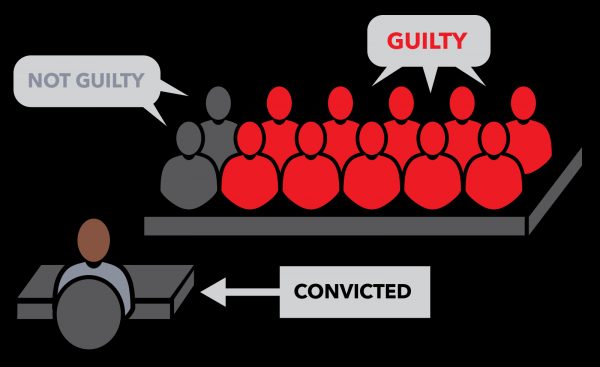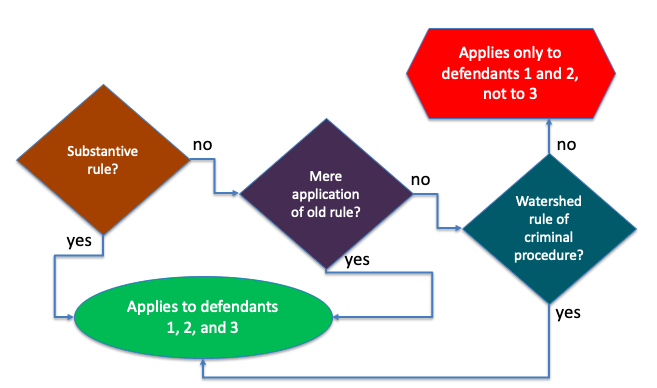
In a recent decision, Ramos v. Louisiana, the Supreme Court found that Louisiana’s rule allowing convictions by a majority of 10 to 2 jurors was unconstitutional. Except for Louisiana and Oregon, all states (and, of course, the federal government) require a unanimous jury verdict, though not all states require twelve jurors (Florida requires only six, except in capital cases.)
Now, the Supreme Court faces a subsequent question: Is Ramos retroactive? As Josh Blackman explains in this brief entry in Reason, some Justices in Ramos itself opined on this: “Justice Kavanaugh said it could not be applied retroactively. Justice Alito’s dissent faulted Justice Kavanaugh for reaching an issue that was not briefed. Justice Gorsuch’s plurality leaned towards it not being-retroactive, but it was non-committal.”
Now, the Court has an opportunity to address this directly. Edwards v. Vannoy, recently added to the calendar, is a habeas case with facts very similar to Ramos. The facts, as reviewed in the petition, make a compelling case that this is not merely an effort built on a technicality. Edwards was apprehended on suspicion of several robberies and a rape, even though the description of the perpetrators (“black males with masks”) did not identify him, and at his interrogation (while chained to the wall!) was dissuaded from consulting an attorney. Here’s how the petition describes the rest of the evidence against Edwards:
The perpetrators of these crimes were young black males wearing black caps, gloves and bandannas covering their faces from the nose down to the chin. The police dusted for prints and collected DNA samples from the various crime scene locations and none of that forensic evidence implicated the accused. The police executed a search warrant at the residences of the accused and his codefendant but did not recover any stolen property, weapons or clothing involved in these crimes. In fact, the alleged weapons and bandannas were found in a vehicle driven by three black male acquaintances of the defendant, none of whom testified at trial. The defendant’s photo lineup was presented to five witnesses and only one was able to make a positive identification. This identification is best described as a “crossracial” identification made by a victim that had only a few seconds to view his assailant’s face. Another witness made a tentative cross-racial identification of the accused. Regrettably, the three individuals in possession of the weapons and bandannas were not placed into a photo lineup for viewing, although one of the victims did participate in a show up identification of these three, but that procedure failed to produce identification.
Edwards v. Vannoy, Petition for Writ of Certiorari
Assuming this is a fair description of the evidence, the case against Edwards was not particularly strong. To complicate matters, the prosecution removed all but one of the African American jurors from the panel during voir dire, and Edwards’ convictions, on all counts, were non-unanimous.
A brief primer on retroactivity: In the diagram below, imagine three defendants: No. 1, whose case begins only after the new rule is in effect; no. 2, whose case was decided before the rule change, but is still “alive” in the sense that it is not final–it is under direct review; and no. 3, whose case is already final, but who, encouraged by the new rule, tries to reopen it via collateral review.

The new rule is always going to apply to defendants 1 and 2, but whether or not it will apply to defendant 3 depends on three questions. The, first question is whether the rule is substantive or procedural. If the new rule is substantive, it will act retroactively; that’s what the Supreme Court decided in Montgomery v. Louisiana, which applied Miller v. Alabama retroactively, leading to reconsiderations of life without parole sentences for many people who have spent decades in prison for crimes committed when they were juveniles under statutory schemes that are now impermissible under Miller (to learn more about these folks, read James Garbarino’s superb Miller’s Children. But I digress.) In our case, however, the rule is procedural; it’s about how the jurors are to decide on a person’s guilt. Under Teague v. Lane, new rules cannot be applied retroactively on habeas, only on direct review, and therefore only defendants 1 and 2 (and not 3) will benefit from the rule change.

The second question is whether this is truly a “new rule” or an application of an old rule. In Davis v. Jones, an appeal of the Orange County federal judge’s decision that the death penalty is unconstitutional because of the delays in its application, respondent’s attorney tried (unsuccessfully)to argue that the new rule was merely an application of Furman v. Georgia.
Even if this is a new procedural rule, it might apply retroactively in the rare case that the third situation applies: if the rule is so fundamental that it can be considered a “watershed rule of criminal procedure.” So far, no habeas petitioner has been successful in arguing retroactivity this way.
How should the lawyers in Edwards approach this? Arguing that this is a substantive rule is a nonstarter, but the other two arguments might have merit, even though each requires a bit of creativity.
One approach could be that the rule in Ramos is not actually a “new rule”, but rather an adaptation of Batson v. Kentucky. The holding in Batson, many readers remember, was that it is unconstitutional to disqualify jurors on the basis of race, and making a prima facie showing of a Batson challenge starts with a pattern of exclusion. Well, in both Louisiana and Oregon, the nonunanimous verdict thing has been intended to function, and indeed functions, as a bypass of Batson. A representative example is Edwards itself: Knowing that you only need 10 jurors to convict, the prosecutor will disqualify all African-American jurors but one or two, thus escaping the need to answer to a Batson challenge but achieving the same outcome: disenfranchising African-American jurors through a combination of a sneaky voir dire tactic and an exploitation of a state rule designed for the very purpose of racist disenfranchisement. As Justice Gorsuch explains in the very beginning of Ramon:
Why do Louisiana and Oregon allow nonunanimous convictions? Though it’s hard to say why these laws persist, their origins are clear. Louisiana first endorsed nonunanimous verdicts for serious crimes at a constitutional convention in 1898. According to one committee chairman, the avowed purpose of that convention was to “establish the supremacy of the white race,” and the resulting document included many of the trappings of the Jim Crow era: a poll tax, a combined literacy and property ownership test, and a grandfather clause that in practice exempted white residents from the most onerous of these requirements. Nor was it only the prospect of African-Americans voting
Ramos v. Louisiana, 590 U. S. __ (2020)
that concerned the delegates. Just a week before the convention, the U. S. Senate passed a resolution calling for an
investigation into whether Louisiana was systemically excluding African-Americans from juries. Seeking to avoid unwanted national attention, and aware that this Court would strike down any policy of overt discrimination
against African-American jurors as a violation of the Fourteenth Amendment, the delegates sought to undermine
African-American participation on juries in another way. With a careful eye on racial demographics, the convention delegates sculpted a “facially race-neutral” rule permitting 10-to-2 verdicts in order “to ensure that African-American juror service would be meaningless.”
Adopted in the 1930s, Oregon’s rule permitting nonunanimous verdicts can be similarly traced to the rise of the Ku
Klux Klan and efforts to dilute “the influence of racial, ethnic, and religious minorities on Oregon juries.” In fact, no one before us contests any of this; courts in both Louisiana and Oregon have frankly acknowledged that race was a motivating factor in the adoption of their States’ respective nonunanimity rules.
In other words, one approach to the retroactivity question could be that the rule in Ramos, which found this practice to be unconstitutional, can be readily understood as the Court’s effort to undo a tricky loophole in the application of Batson, which dates back to 1986. This reading would date the rule not to 2020, but to 1986, and would apply it to any case that was still in the appellate pipeline when pastels, neons, and shoulder pads were all the rage. Edwards’ appeal was denied only in 2009, so he would benefit from this reading.
Another approach would be to argue that the Ramos holding is a watershed rule of criminal procedure because, in the words of Teague, it “”implicat[es] the fundamental fairness of the criminal proceeding.” An easy probabilistic calculation shows the risk of conviction rises with non-unanimous juries. Think about it this way: with a unanimous 12-person jury, you need one person to insist on acquittal to get to a hung jury. With a non-unanimous 10:2 rule, you need three. With every reduction in the number of people who have to agree to convict, we are decreasing the voice of an unpopular opinion–which, as Henry Fonda reminds us in Twelve Angry Men, is essential for the functioning of the system.
Consider the following analogy between the Ramos holding and the rule announced in in re Winship: Before Winship, the burden of proof in juvenile proceedings was preponderance of the evidence (more than 50%.) The Court found this burden to deprive criminal defendants of their fundamental constitutional safeguard against the possibility that their fate be incorrectly decided due to fact-finding errors–the heightened burden of proof required for a criminal conviction. Ramos “implicat[ed] the fundamental fairness of the criminal proceeding” in a very similar way. Suppose, for example, that beyond reasonable doubt requires 90% certainty in each individual juror’s mind. Introduce non-unanimity and you’ve reduced the aggregate burden of proof to 90% certainty in 10 minds and 0% certainty in 2 minds. Those are significantly different odds, and in the aggregate they result in different odds of conviction–in much the same way that reducing the overall burden of proof does.
So much for the legal arguments. Policy-wise, I can see the Court contemplating the scary prospect of invalidating an entire history of trials in both Louisiana and Oregon–new trials for people whose cases have been final for decades! This prospect might have been what propelled Justices Kavanaugh and (to a lesser extent) Gorsuch to jump the gun and offer dicta in Ramos about it not being retroactive. Some of the concern with the mess retroactivity will wreak upon convictions in these states might be ameliorated by requiring, as for any reversal, a harmless error test. Moreover, there is another important policy argument that cuts the opposite way: because this rule has such an obvious racial animus behind it, applying it retroactively, as in Batson, would have a cleansing effect akin to the destruction of a confederate monument.




No comment yet, add your voice below!